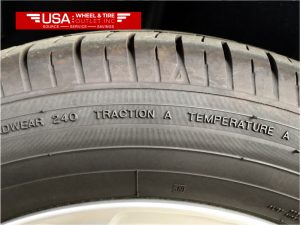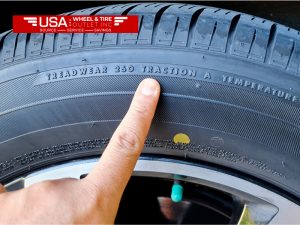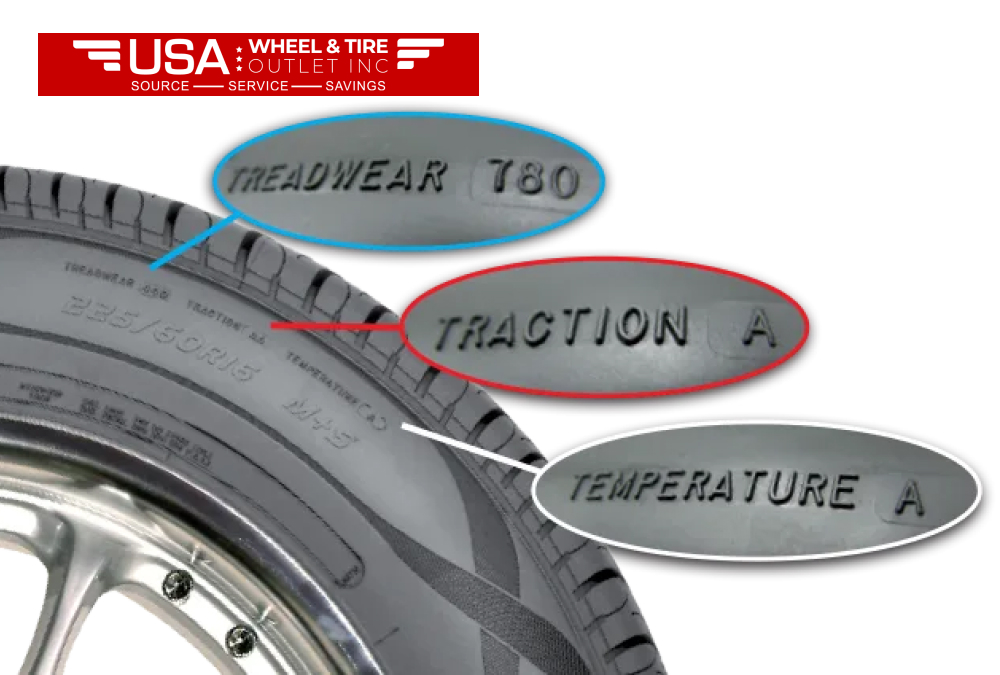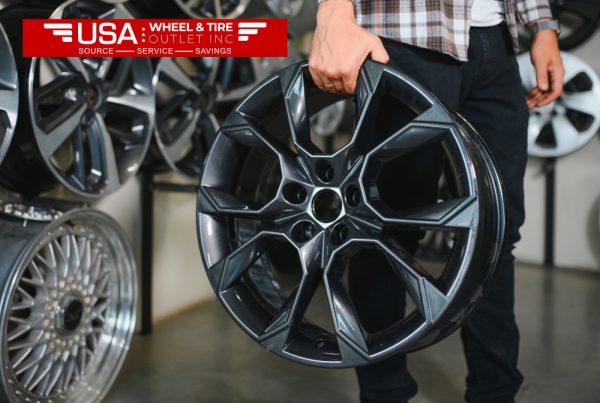There is nothing more important than proper selection for the tires of your car. That’s where the tire grading chart can best be used for you. The U.S. Department of Transportation or DOT has established such a system and provides detailed information about a tire’s overall performance and rating on traction, treadwear, and temperature resistance.
This blog breaks down the tire grading chart and tells you what all of this really means so you can make a proper selection based on your needs.
What is the Tire Grading Chart?
The tire grading chart is a standardized measure for judging tires’ quality and performance. These grades rate them according to three primary factors:
This brings with it each of these areas of each tire. A consumer will therefore be informed of what they purchase. Each of the grades typically appears on a sidewall label to make tires that bit easier to compare.
1. Treadwear Grades
Treadwear grades are measures of tread durability. The higher the grade, the longer the tire will last. This number, which is expressed as a three-digit number, is derived from controlled tests. A tire with a treadwear grade of 400 will last much longer than a tire graded at 200.
How Treadwear Grades Are Determined
It undergoes the standardized course process. At different times, the tire goes through wear, and a resultant is measured against a comparison tire; normally, at 100. For example:

Grade 200 The tire lasts twice that of the comparison tire.
Grade 400 That tire lasts four times that of the comparison tire.
These grades are an approximate measure of how long the tire will last, but the actual wear can vary with many other conditions such as driving style, road conditions, and climate.
Guidelines in Picking the Correct Treadwear Grade
For commuters: High treadwear grade tires ideal with treadwear grades 300 and above for durability.
For performance vehicles: Low treadwear grade tires 200 and below are best for better grip, but wear out faster.
2. Traction Grades
The capability of a tire to halt on wet pavement is indicated by the traction ratings. These ratings are based on simulated emergency stop tests in wet and dry conditions. It can rate from AA down to C.
Why Traction Ratings Matter
Traction ratings are vital for safety, especially on wet or slippery roads. Tires with high traction ratings provide superior control and shorter stopping distances, significantly lowering the risk of accidents. For optimal safety in rainy or wet conditions, choosing AA or A-rated traction tires is advisable.
USA Wheels & Tires INC highlights the importance of selecting the right traction rating to enhance road grip and ensure a secure driving experience under various weather conditions.

3. Temperature Resistance
Temperature resistance grades are indicators of how well a tire is resistant to heat generated during driving. A grading system is based on the capacity of a tire to dissipate heat, which izuite crucial in preventing blowouts or premature wear. It is rated from A to C based on temperature resistance.
Temperature Resistance Significance
Sports cars and highways use high-performance tires that require excellent temperature resistance. A tire with a C rating may not work well in hot conditions, particularly on long drives at high speeds.
For most standard vehicles, B or A ratings are ideal. For those who drive in colder climates, or for shorter drives, however, C is probably fine.
Reading Tire Labels and Grades
Tire labels provide much of the information about the tire performance. Let’s take an overview of common elements one will find on the tire sidewall.
Tire Type and Size: It gives information on the type of tire, such as passenger, truck, and its measurement, such as 205/55R16.
How to Select Tires Using the Tire Grading Chart
When selecting tires, the tire grading chart can help you make a decision. Here’s how to use it:
1. Evaluate Your Driving Conditions
If you reside in a hot climate or drive very frequently at high speeds, you need temperature resistance. If you often drive in rainy conditions, then you should consider the traction ratings.
2. Choose Treadwear for Long Life
If you are going to keep your car for a long time, you should opt for tires with higher treadwear grades. In this way, you will get the most out of the money you spent.
3. Choose Your Driving Style
If you like driving sporty or even performance cars, you can have tires with lower treadwear grade and higher traction ratings. For daily driving, focus on treadwear and temperature for durability.
4. Look at the Label
Always check the sidewall label of the tire for traction and temperature ratings. This will have a direct impact on your safety and the performance of the tire.
Key Takeaways
Tire Grading Chart: A standardized system to evaluate tire performance.
Treadwear Grades: Indicate the expected lifespan of the tire, with higher grades meaning longer-lasting tires.
Traction Ratings: Show how well the tire performs on wet surfaces, with AA being the highest rating.
Temperature Resistance: Reflects the tire’s ability to handle heat, with A being the best.
Select Wisely: Look at your driving conditions, vehicle type, and preferences before selecting tires from these ratings.
Understanding Tire Performance Beyond the Grades
While the tire grading chart is crucial to give one a comprehensive feel for the durability, traction, and temperature resistance of the tire, one should remember that these ratings are just a starting point. With features coming with a tires set of characteristics, one should be able to gain further insight into the options they can have in making their ultimate selection.
1. Driving habits and road conditions
Driving habits significantly determine how long your tires will last and how they will perform. For instance, aggressive driving such as hard braking, rapid acceleration, or high-speed cornering causes more stress on the tire and leads to quicker deterioration.
The same goes for road conditions that you frequently pass through. More wear could be caused by potholes, rough roads, and extreme weather conditions, such as snow or rain. For those who drive mainly on highways with smooth, dry roads, a higher treadwear grade might be the best. On the other hand, if your driving often involves off-road conditions or rough terrain, a tire with a more robust traction rating and suitable tread pattern would be ideal.
2. Types of Tires and How They Affect Grading
There are different types of tires that are meant for different types of environments, and the choice of the tire grading can depend on the one you choose:
All-Season Tires: For general service conditions, such tires provide the right mix of treadwear, traction, and resistance to temperature. The tire has moderate treadwear grade usually in the range 250-400 and matches well with all types of weather.
Summer Tires: These are made for high temperatures and are awesome on dry as well as moist surfaces. Their traction rating is mostly AA or A, but treadwear grade is quite poorer, either under 200, or in other words, they can deliver but might wear easily in regular use.
Winter Tires: These tires are designed exclusively for snowy or icy road conditions. The tread pattern is unique to these types of tires, as well as being built for colder temperatures. While these tires will be a must-have for driving during the winter, they will likely not offer the same performance as an all-season or summer tire in a warmer climate. Treadwear grades for winter tires vary but tend to be better with traction in cold conditions compared to temperature resistance.
Each type of tire is designed for a certain environment, and it’s essential to have the appropriate type of tire for your driving environment.
3. Effects of Tire Inflation on Performance
Tire inflation also impacts the performance of your tires and the grading of the tire. Even the slightest underinflation or overinflation may shorten the life of your tire and reduce its treadwear, traction, and temperature resistance.
Proper tire pressure is required to ensure that the grading of the tire is true to real-world performance. Always refer to your owner’s manual or the sidewall of the tire for the correct inflation level.
4. Limitations of the Grading System
The grading system is a good guide, but it does not capture everything about tire performance. Some factors that are not reflected in the grades include:
Ride Quality: How silky the ride is can be affected by tread patterns, construction of the tire and quality of the material. These factors are not graded.
Noise Level: While driving, some tires may make more noise than others. Noise while driving is important for comfort but not graded.
Tire Handling: Overall dry-handling capability—cornering ability, and road feel—is established through factors such as the makeup of the tire and quality of the rubber used.
When purchasing, note that these specs are only based on what the manufacturer says it should have and by what customer ratings and grades are.
5. Proper Care for Best Performance
Once you’ve picked tires according to the grading scale, regular maintenance will determine when to change the tires as well as when they get their best performance.
For that reason, here are several key maintenance tips:
check tire pressure: Under-or over-inflated tyres can have an adverse influence on performance. Check them monthly and before a long drive.
Rotate your tires: Tires should be rotated regularly in order to ensure even tread wear. It’s usually recommended every 6,000 to 8,000 miles, but this may differ based on your vehicle and tire type.
Examine tires for damage: Check tires for signs of wear, punctures, or cracks in the tire. Any of these visible damages should be addressed right away because it can cause safety hazards.
Balance your tires: Balancing the tires assures uniform wear and can even enhance the performance of handling along with fuel efficiency.
Using this together with proper maintenance is what ensures that these tires will operate at their best in the long run.
Conclusion
The tire grading chart is that very valuable tool that will enable a prudent decision during purchase. Understanding treadwear grades, traction ratings, and temperature resistance is important in selecting the right tyre for your driving habits and conditions. Remember that these grades do not capture every aspect of tire performance. Make sure also to take into account ride comfort, handling, and noise levels when choosing what would be your next set of tires. Finally, the right maintenance of your tires through checking and rotation will increase their lifespan, enhance their performance significantly.
Finally, selecting the correct tire is not merely picking up the highest ratings but rather achieving that balance which works best for your needs. If it’s just for regular commute or performance driving, then this tire grading chart will give you the right path in selecting the safest and most efficient one for your vehicle.
Read Also: How Does a TPMS Sensor Work? A Guide to Tire Pressure Safety
FAQs
1. What is a Tire Grading Chart?
A tire grading chart refers to the rating of how well a tire performs on three critical properties; treadwear, traction, and temperature resistance. This chart standardizes the way tires are compared in terms of durability, grip, and heat resistance, hence encouraging the consumers to make informed decisions while purchasing.
2. What is Treadwear Grade?
Treadwear grade is the mileage a tire is expected to last. It is measured relative to a reference tire that has grade 100. For example, a tire with grade 200 lasts twice as long as the reference tire. If a tire has a higher treadwear grade it is more durable and perfect for longer drives.
3. How is Traction Rating Determined?
Traction ratings represent the capabilities of tires on wet roads. The rating is obtained by tests that mimic emergency braking. Ratings are usually in the form of AA, A, B, or C. Wet traction rating AA is the best. The more traction, the better the grip and the shorter stopping distances in rainy or slippery weather.
v4. What Is Temperature Resistance on a Tire?
Temperature resistance is the ability of a tire to resist heat buildup from driving. The rating ranges from A, which is the best, to C, which is the lowest. Tires rated A can tolerate high speed and temperature without developing heat buildup that could damage or cause a blowout. C-rated tires are best suited for slower speeds and less stressful driving.
5. How Do I Interpret The Tire Grading Label?
The tire grading label will be molded into your tire sidewall and displays for you the treadwear grade, traction rating, and temperature resistance. An example tire might have “Treadwear: 300, Traction: A, Temperature: B,” hence reading rapidly of durability, efficiency of wetting, and managing heat.
v6. What Would a Good Treadwear Grade Be for My Tire Tires?
The perfect treadwear rating will vary on the way you drive.
If you drive regularly for regular, everyday driving, 300 or higher will offer the right balance of wear life and performance. But if you’re a heavy driver, if you accelerate frequently, or drive long miles in extreme weather conditions, a tire with a lower treadwear grade may be better for your application.
7. Why Are Traction Ratings Important?
Traction ratings help to ensure safety. Higher the traction ratings of tires, they perform better on roads wet, slippery, or covered with snow and decrease the chances of accidents. Ideal tires with high traction ratings in such places where rainfall is often frequent or snow covers, are needed for optimum grip and performance on the roads.
8. Can Temperature Resistance Impact Tire Performance?
Yes, temperature resistance is very important to the tire performance. Low-temperature-rated tires with ratings of (C) will probably degrade quicker in high-speed or hot-weather conditions. High-temperature-rated tires show that your tires are safe and durable for the worst conditions possible to bring even more safety and performance into your vehicle.
9. Does it always follow that Better Rated Tires are Better Tires?
Not necessarily. While better grades often signify better performance, the best tire is that which depends on your own driving habits, climate conditions, and kind of automobile you own. For example, high-performance tires offering low treadwear grades do better in road handling but will leave you sooner than you think it would. On the contrary, all-season tires often offer middling grades; they will serve you with more durability.
10. How Can I Use This Tire Grading Chart to Choose Best Tire?
Use the grading chart and your driving conditions to determine which tire will best suit your needs. If you live in a hot climate, look for tires that are resistant to heat. If you drive through wet or snowy conditions, look for tires that have a high traction rating. Lastly, pick a treadwear grade you expect your tires to go through before replacing them.





